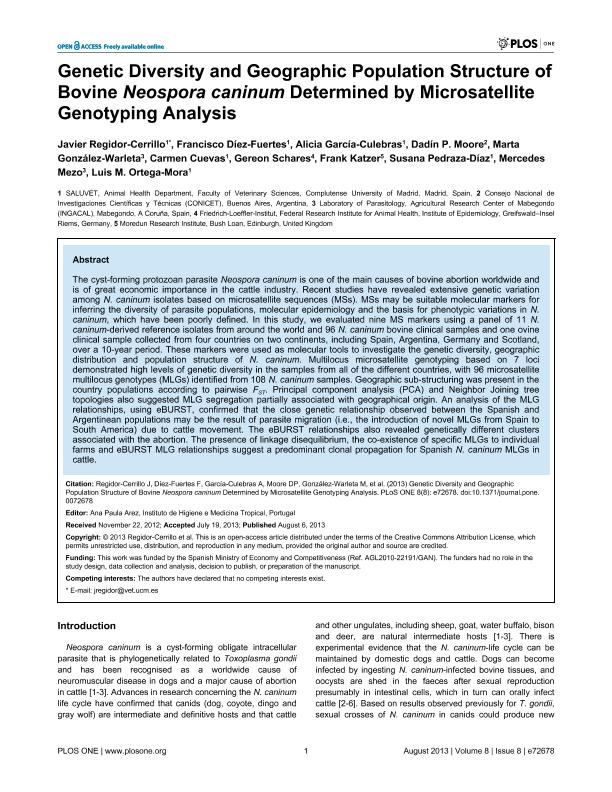Mostrar el registro sencillo del ítem
dc.contributor.author
Regidor Cerrillo, Javier
dc.contributor.author
Díez Fuertes, Francisco
dc.contributor.author
García Culebras, Alicia
dc.contributor.author
Moore, Dadin Prando

dc.contributor.author
González Warleta, Marta
dc.contributor.author
Cuevas, Carmen
dc.contributor.author
Schares, Gereon
dc.contributor.author
Katzer, Frank
dc.contributor.author
Pedraza Diaz, Susana
dc.contributor.author
Mezo, Mercedes
dc.contributor.author
Ortega Mora, Luis M.
dc.date.available
2017-09-26T16:56:45Z
dc.date.issued
2013-08
dc.identifier.citation
Regidor Cerrillo, Javier; Díez Fuertes, Francisco; García Culebras, Alicia; Moore, Dadin Prando; González Warleta, Marta; et al.; Genetic Diversity and Geographic Population Structure of Bovine Neospora caninum Determined by Microsatellite Genotyping Analysis; Public Library of Science; Plos One; 8; 8; 8-2013; e7267801-e7267812
dc.identifier.issn
1932-6203
dc.identifier.uri
http://hdl.handle.net/11336/25122
dc.description.abstract
The cyst-forming protozoan parasite Neospora caninum is one of the main causes of bovine abortion worldwide and is of great economic importance in the cattle industry. Recent studies have revealed extensive genetic variation among N. caninum isolates based on microsatellite sequences (MSs). MSs may be suitable molecular markers for inferring the diversity of parasite populations, molecular epidemiology and the basis for phenotypic variations in N. caninum, which have been poorly defined. In this study, we evaluated nine MS markers using a panel of 11 N. caninum-derived reference isolates from around the world and 96 N. caninum bovine clinical samples and one ovine clinical sample collected from four countries on two continents, including Spain, Argentina, Germany and Scotland, over a 10-year period. These markers were used as molecular tools to investigate the genetic diversity, geographic distribution and population structure of N. caninum. Multilocus microsatellite genotyping based on 7 loci demonstrated high levels of genetic diversity in the samples from all of the different countries, with 96 microsatellite multilocus genotypes (MLGs) identified from 108 N. caninum samples. Geographic sub-structuring was present in the country populations according to pairwise FST. Principal component analysis (PCA) and Neighbor Joining tree topologies also suggested MLG segregation partially associated with geographical origin. An analysis of the MLG relationships, using eBURST, confirmed that the close genetic relationship observed between the Spanish and Argentinean populations may be the result of parasite migration (i.e., the introduction of novel MLGs from Spain to South America) due to cattle movement. The eBURST relationships also revealed genetically different clusters associated with the abortion. The presence of linkage disequilibrium, the co-existence of specific MLGs to individual farms and eBURST MLG relationships suggest a predominant clonal propagation for Spanish N. caninum MLGs in cattle.
dc.format
application/pdf
dc.language.iso
eng
dc.publisher
Public Library of Science

dc.rights
info:eu-repo/semantics/openAccess
dc.rights.uri
https://creativecommons.org/licenses/by-nc-sa/2.5/ar/
dc.subject
Genetic Diversity
dc.subject
Neospora Caninum
dc.subject
Cattle
dc.title
Genetic Diversity and Geographic Population Structure of Bovine Neospora caninum Determined by Microsatellite Genotyping Analysis
dc.type
info:eu-repo/semantics/article
dc.type
info:ar-repo/semantics/artículo
dc.type
info:eu-repo/semantics/publishedVersion
dc.date.updated
2017-09-07T16:54:05Z
dc.journal.volume
8
dc.journal.number
8
dc.journal.pagination
e7267801-e7267812
dc.journal.pais
Estados Unidos

dc.journal.ciudad
San Francisco
dc.description.fil
Fil: Regidor Cerrillo, Javier. Universidad Complutense de Madrid; España
dc.description.fil
Fil: Díez Fuertes, Francisco. Universidad Complutense de Madrid; España
dc.description.fil
Fil: García Culebras, Alicia. Universidad Complutense de Madrid; España
dc.description.fil
Fil: Moore, Dadin Prando. Consejo Nacional de Investigaciones Científicas y Técnicas; Argentina
dc.description.fil
Fil: González Warleta, Marta. Agricultural Research Center of Mabegondo; España
dc.description.fil
Fil: Cuevas, Carmen. Universidad Complutense de Madrid; España
dc.description.fil
Fil: Schares, Gereon. Agricultural Research Center of Mabegondo; España
dc.description.fil
Fil: Katzer, Frank. Moredun Research Institute; Reino Unido
dc.description.fil
Fil: Pedraza Diaz, Susana. Universidad Complutense de Madrid; España
dc.description.fil
Fil: Mezo, Mercedes. Agricultural Research Center of Mabegondo; España
dc.description.fil
Fil: Ortega Mora, Luis M.. Universidad Complutense de Madrid; España
dc.journal.title
Plos One

dc.relation.alternativeid
info:eu-repo/semantics/altIdentifier/url/http://journals.plos.org/plosone/article?id=10.1371/journal.pone.0072678
dc.relation.alternativeid
info:eu-repo/semantics/altIdentifier/doi/http://dx.doi.org/10.1371/journal.pone.0072678
Archivos asociados
